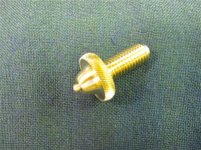Juan Hovey
Plastic
- Joined
- Mar 8, 2016
I'm finishing work on four No. 3 infills to take to the Lee-Nielsen open house next month in Maine - two in Honduran rosewood, two in Gabon ebony - and the wrinkle on the prune is that two of them come with more-or-less traditional knobs in front, displacing the "gasping fish" buns that have graced or, as some would have it, defaced my planes until now.
Here they are:


The rosewood fish-mouth plane won an honorable mention last summer in the Design in Wood competition at Del Mar, and as I happened to glom onto a quantity of ebony earlier this year, I decided to make a second No. 3 to match it, more or less.
There was some ebony left over - and some rosewood, too. So, what the heck, I decided to try my hand at making a plane with a knob.
Make that two planes, one in ebony, one in rosewood.
I sweated the details on these two planes, believe me; as always, my goal was find those points in my work processes which, if I improved on them, would produce a substantially improved plane.
If the proof is in the pudding, take a look at what one of the planes did with some ornery black locust:

Here is the same plane working against the grain:

The irons on these planes are made of A-2 tool steel, set at 45 or 50 degrees. The sides are mild steel dovetailed and pinned to bases of 0-1 tool steel.
I'm working on a No. 4 in Bastogne walnut in hopes of taking it to the L-N open house as well.
Hope to see folks who frequent this forum there. Meanwhile, cheers from Santa Maria, California, where the summer fog rolls in shortly after dusk and peels back an hour or two after sunrise, giving way to sunshine so brilliant it brings tears to the eyes.
Here they are:


The rosewood fish-mouth plane won an honorable mention last summer in the Design in Wood competition at Del Mar, and as I happened to glom onto a quantity of ebony earlier this year, I decided to make a second No. 3 to match it, more or less.
There was some ebony left over - and some rosewood, too. So, what the heck, I decided to try my hand at making a plane with a knob.
Make that two planes, one in ebony, one in rosewood.
I sweated the details on these two planes, believe me; as always, my goal was find those points in my work processes which, if I improved on them, would produce a substantially improved plane.
If the proof is in the pudding, take a look at what one of the planes did with some ornery black locust:

Here is the same plane working against the grain:

The irons on these planes are made of A-2 tool steel, set at 45 or 50 degrees. The sides are mild steel dovetailed and pinned to bases of 0-1 tool steel.
I'm working on a No. 4 in Bastogne walnut in hopes of taking it to the L-N open house as well.
Hope to see folks who frequent this forum there. Meanwhile, cheers from Santa Maria, California, where the summer fog rolls in shortly after dusk and peels back an hour or two after sunrise, giving way to sunshine so brilliant it brings tears to the eyes.


 ) with developing technically and esthetically as a plane maker. Also prolific - puts people like me to shame for sheer productivity.
) with developing technically and esthetically as a plane maker. Also prolific - puts people like me to shame for sheer productivity.



